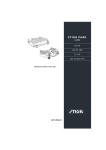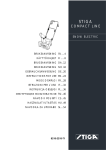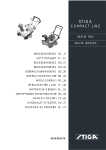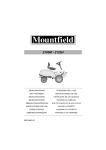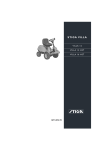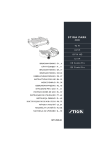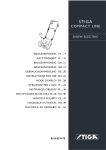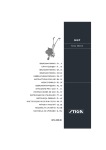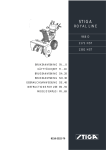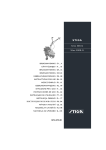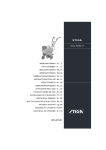Download Stiga SNOW RISE 8218-2220-70 User's Manual
Transcript
STIGA DUO LINE Snow Rise BRUKSANVISNING SV .... 5 KÄYTTÖOHJEET FI ... 12 BRUGSANVISNING DA . 19 BRUKSANVISNING NO. 26 GEBRAUCHSANWEISUNG DE .. 33 INSTRUCTIONS FOR USE EN .. 40 MODE D’EMPLOI FR ... 47 ISTRUZIONI PER L´USO IT .... 54 INSTRUKCJA OBS£UGI PL ... 61 »HC“P”K÷»fl œOÀ‹«Œ¬¿“EÀfl RU.. 69 NÁVOD K POU®ITÍ CS... 78 HASZNÁLATI UTASÍTÁS HU . 85 NAVODILA ZA UPORABO SL.... 92 8218-2220-70 1 1 2 3 4 6 5 7 8 10 11 9 12 16 13 14 15 2 3 B A C 2 5 4 F D G E 7 6 H H T U 8 V I A B 9 3 EN ENGLISH 1 SYMBOLS The following symbols appear on the machine. They are there to remind you of the care and attention required in use. This is what the symbols mean: Warning. 2.2 PREPARATIONS • Check the area to be cleared and remove any loose or foreign objects. • Disengage all controls before starting the engine. • Never use the snow thrower unless properly dressed. Wear footwear that improves your grip on a slippery surface. • Warning – Petrol is highly inflammable. Read and understand the owner’s manual before using this machine. Disconnect the spark plug wire, and consult technical literature before performing repairs or maintenance. Danger - rotating fan. Danger - rotating auger. • Keep hands out of discharge chute. • Never, under any circumstances, make adjustments while the engine is running (unless otherwise specified in the instructions). • Allow the snow thrower to adjust to the outdoor temperature before using it. • Always use protective goggles or a visor during use, maintenance and service. Keep hands and feet away from rotating parts. Risk of burns. Keep bystanders at a safe distance from the machine. Never point the discharge chute towards bystanders. Use hearing protection. 2 SAFETY INSTRUCTIONS 2.1 GENERAL • Please read through these instructions carefully. Learn all the controls and the correct use of the machine. • Never allow children or anyone who is not familiar with these instructions to use the snow thrower. Local regulations may impose restrictions as regards the age of the driver. • Never use the machine if others, particularly children or animals, are in the vicinity. • Remember that the driver is responsible for accidents that happen to other people or their property. • Be careful not to trip or fall, especially when reversing the machine. • Never use the snow thrower under the influence of alcohol or medication and if you are tired or ill. 40 a. Always store petrol in containers that are made especially for this purpose. b. Only fill or top up with petrol outdoors, and never smoke when filling or topping up. c. Fill with petrol before starting the engine. Never remove the filler cap or fill with petrol while the engine is running or still warm. d. Screw the filler cap on tightly and wipe up any spilt petrol. Adjust the height of the auger housing to ensure it stays above gravel paths. 2.3 OPERATION • Keep hands and feet away from rotating parts. Always avoid the discharge chute opening. • Be careful when driving on or crossing gravel paths, pavements and roads. Be aware of hidden dangers and traffic. • Never direct the discharge chute towards a public road or traffic. • If the snow thrower hits a foreign object, stop the engine, disconnect the spark plug cable and carefully inspect the machine for damage. Repair the damage before using the machine again. • If the machine starts vibrating abnormally, stop the engine and look for the cause. Vibration is normally a sign of something wrong. • Stop the engine and disconnect the spark plug cable: a. If the machine steers away from the driving position. b. If the auger housing or discharge chute is blocked and must be cleaned. c. Before beginning repairs or adjustments. • Always make sure the rotating parts have stopped and all the controls are disengaged before cleaning, repairing or inspection. • Before leaving the machine unattended, disengage all the controls, put it into neutral gear, stop the engine and remove the ignition key. • Never run the engine indoors except when taking it in and EN ENGLISH out of its place of storage. In this case ensure the door to the storage place is open. Exhaust fumes are toxic. 3 ASSEMBLY • Never drive across a slope. Move from the top down, and from the bottom to the top. Be careful when changing direction on a slope. Avoid steep slopes. Note: Instructions to the left and right sides start from the driving position behind the snow thrower. • Never operate the machine with insufficient protection or without the safety devices in place. • Existing safety devices must not be disconnected or disengaged. • Do not alter the engine’s regulator setting and do not race the engine. The possibility of personal injury increases when the engine is run at high revs. 3.1 CONTENTS - OUTER PACKING The packing contains: - One snow thrower - One adjustment lever - One gear rod - One discharge chute - One set of instructions - One assembly kit • Never use the snow thrower near enclosures, cars, windowpanes, slopes etc. without properly setting the discharge chute deflector. • Always keep children away from areas to be cleared. Get another adult to keep the children under supervision. • Do not overload the machine by driving it too fast. • Take care when reversing. Look behind you before and during reversing to check for any obstacles. • Never point the discharge chute towards bystanders. Do not allow anyone to stand in front of the machine. • Disengage the auger when the snow thrower is to be transported or is not in use Do not drive too fast on slippery surfaces when transporting. • Only use accessories that are approved by the machine’s manufacturer. • Never drive the snow thrower in bad visibility or without satisfactory lighting. • Always ensure you have a good balance and a tight grip on the handle. • Never use the snow thrower on a roof. • Do not touch engine components because they are warm during use. Risk of burn injuries. 2.4 MAINTENANCE AND STORAGE • Tighten all nuts and screws so that the machine is in safe working condition. Check the shear bolts regularly. • Always use genuine spare parts. Non-genuine spare parts can entail a risk of injury, even if they fit the machine. • Never store the machine with petrol in the tank in buildings where the fumes can come into contact with open flames or sparks. • Allow the engine to cool before putting the machine in store. • Before a long storage, check the instructions for recommendations. • Replace damaged warning and instruction stickers. • Let the engine run a couple of minutes with the auger connected after use. This prevents the auger from freezing solid. 3.2 UNPACKING 1. Remove all loose items from the carton. 2. Cut off the plastic straps holding the adjustment lever and the gear rod. 3. Cut the four corners of the carton and let the sides fall down. 4. Unscrew the screws (X) that fasten the shoes to the bedding. See fig. 1. 5. Roll the snow thrower from the carton. 6. Cut the plastic tape holding the control wires on the underside of the handle. 3.3 HANDLE, SEE FIG. 2, 3 1. Hook on the auger and drive wires Z-nipples into their handles. 2. Assemble the handle with the following parts: A Four Screws B Two Support plates for the upper screws C Two Washers for the lower screws 3. Tighten the four screws. 3.4 SNOW DISCHARGE CHUTE, SEE FIG. 4 1. Place the discharge chute (D) on the flange against the worm gear. 2. Mount the three carriage pieces (E) with two screws each. 3. Tighten properly. 3.5 ADJUSTMENT LEVER, SEE FIG. 5 1. Assemble the eyebolt (F) in the handle. 2. Insert the shaft end into the plastic bushing and adapt the worm gear to the recesses in the discharge chute. 3. Lock the joint with the locking pin (G). 4. Check the discharge chute by turning it fully in both directions. The chute should rotate freely. 3.6 GEAR LEVER, SEE FIG. 6 Assemble the gear lever to the gearbox shaft as follows: 1. Set up the machine on the auger housing and set the ger lever (H) in the first gear forwards. See fig. 6. 2. Assemble the screw (I) through the angle joint and shaft. Tighten the screw. 3. Tighten the upper screw (T) between the gear lever and the angle joint. 4. Tighten the lower screw (U) between the gear lever and the angle joint. 41 EN ENGLISH 5. Tighten the screw (V) until the gear lever remains in the gear positions in the panel plate. 6. Set down the machine on its wheels. 3.7 CHECKING THE CONTROL WIRES The control wires might need adjusting before using the snow thrower for the first time. See ADJUSTING THE CONTROL WIRES below. 3.8 TYRE PRESSURE Check the air pressure in the tyres. See “6.5”. 4 CONTROLS The motor is equipped with a protection grid. The motor may never be started without the grid fitted or with a defect grid. See fig. 1. 4.1 THROTTLE (16) Controls the engine’s revs. The throttle has three positions: 1. Full throttle 2. Idling. 4.2 CHOKE (3) Used when starting a cold engine. The choke has two positions: 1. The choke is open 4.8 OIL DRAINING PLUG (14) For draining the old engine oil when changing the oil. 4.9 SPARK PLUG PROTECTION (1) The protection is easily removable by hand. The spark plug is located under the protection. 4.10 GEAR LEVER (4) The machine has 5 forward gears and 2 reverse to regulate the speed. The gear stick must not be moved if the driving clutch lever is depressed. 4.11 CLUTCH LEVER- DRIVING (6) Engages the wheels when put into gear and the lever is pushed towards the handle. Situated on the left side of the handle. 4.12 CLUTCH LEVER- AUGER (7) Connects the auger and fan when the lever is pushed down towards the handle. Situated on the right side of the handle. 4.13 ADJUSTMENT LEVER (5) Changes the direction of the discharged snow. 1. Turn the lever clockwise – the discharge turns to the left. 2. Turn the lever anti-clockwise – the discharge turns to the right. 2. The choke is closed (for cold starting) 4.3 STOP SWITCH (13) Used to stop the engine. The switch has two positions: 0– The engine stops, engine can not start. 1– The engine can be started, engine running. 4.4 STARTING HANDLE (12) Manual cord start with rewinding. 4.5 4.6 DIPSTICK (15) For filling and checking the oil level in the engine. The dipstick has two level marks: FULL = maximum oil level ADD = minimum oil level FILLER CAP (8) For filling with petrol. 4.7 FUEL COCK(3) The fuel cock opens the fuel supply to the carburettor. The fuel cock shall always be closed when the machine is not in use. Downwards - open. To the right - closed. 42 4.14 SHOES (11) Used to set the height of the auger housing above the ground. 4.15 WHEEL LOCK See fig. 7. The left wheel is mounted on the wheel shaft with the help of a locking pin. The locking pin can be moved to two positions: A) Inner position – two-wheel drive. B) Outer position – one-wheel drive. Simplifies manoeuvring the machine when turning. - Used during lighter conditions. - When storing the machine. 4.16 CHUTE DEFLECTOR (9) Losen the wing nuts and adjust the chute deflector to a suitable height. Low - shorter ejection distance. High - longer ejection distance. ENGLISH 5 USING THE SNOW THROWER 5.1 GENERAL Never start the engine until all the above measures under ASSEMBLY have been carried out. Never use the snow thrower without first reading and understanding the instructions and all the warning and instruction stickers on the machine. Always use protective goggles or a visor during use, maintenance and service. 5.2 BEFORE STARTING Some snow throwers are delivered without oil in the engine. Fill the engine with oil before using. Do not start the engine until filled with oil. The engine can be seriously damaged without oil. 1. Place the machine on a level floor. 2. Loosen the dipstick and fill with oil up to the FULL mark See fig. 8. 3. Use good quality oil marked A.P.I service SF, SG or SH. Use SAE 5W30 - 10W40 oil. 4. The crankcase holds: 0.45 litres. Always check the oil level before using. The snow thrower must stand on level ground when checking. 5.3 FILL UP THE PETROL TANK Always use lead-free petrol. Oil-mixed 2-stroke petrol must not be used. NOTE! Bear in mind that ordinary lead-free petrol is perishable; do not purchase more petrol than can be used within thirty days. Environmental petrol can be used, i.e. alkylate petrol. This type of petrol has a composition that is less harmful for people and nature. Petrol is highly inflammable. Always store fuel in containers that are made especially for this purpose. Store the petrol in a cool, well ventilated place – not in the house. Store the petrol well out of reach for children. Only fill or top up with petrol outdoors, and never smoke when filling or topping up. Fill with fuel before starting the engine. Never remove the filler cap or fill with petrol while the engine is running or still warm. Do not fill the petrol tank right to the top. After filling, screw the filler cap on tightly and wipe up any spilt petrol. 5.4 STARTING THE ENGINE, SEE FIG. 1 Do not touch engine components because they are warm during use and up to 30 minutes after use. Risk of burn injuries. Never run the machine indoors. The exhaust fumes contain carbon monoxide, a very toxic gas. 1. Make sure the driving (6) and auger (7) clutch levers are disengaged. 2. Set the stop switch (13) in position “1”. EN 3. Turn the choke (3) to position . Note: A warm engine does not need the choke. 4. Pull on the starter cord until you feel resistance. Start the engine with a sharp pull. 5. When the engine starts, reset the choke until it is fully open. 5.5 STOPPING 1. Release both clutch levers. Note. If the snow thrower continues rotating - see ADJUSTING THE CONTROL WIRES below. 2. Set the stop switch (13) in position “0”. 5.6 STARTING 1. Start the engine as above. Let the engine run a few minutes to warm before use. 2. Set the chute deflector. 3. Turn the adjustment lever and set the deflector to throw the snow in the direction of the wind. The gear stick must not be moved if the driving clutch lever is depressed. 4. Set the gear lever to a suitable position. 5. Press down the auger clutch lever to activate the auger and discharge fan. Watch out for rotating auger. Keep hands, feet, hair and loose clothing away from any moving parts on the machine. 6. Press down the auger clutch lever. The snow thrower now moves forward or backwards depending on the gear you have chosen. 5.7 DRIVING TIPS The silencer and surrounding parts become very hot when the engine is running. Risk of burns. 1. Always adapt the speed to the snowy conditions. Regulate the speed with the gear stick. 2. Snow is more effectively removed directly after falling. 3. Always throw the snow in the direction of the wind if possible. 4. Adjust the shoes with the screws (11 in fig. 1) to suit the ground conditions: - On flat ground, e.g. asphalt, the shoes should be about 3mm under the scraping blade. - On uneven ground, e.g. gravel paths, the shoes should be about 30mm under the scraping blade. Always adjust the shoes so that gravel and stones are not fed into the snow thrower. There is a risk for personal injury if these are thrown out at high speed. Ensure the shoes are adjusted the same on both sides. 5. Adapt the speed so that the snow is thrown in an even stream. If snow fastens in the chute do not try to remove it before: - Releasing both clutch levers. - Stopping the engine. - Disconnecting the cable from the spark plug. - Do not put your hand inside the chute or auger. Use a wooden stick. 43 EN ENGLISH 5.8 AFTER USE 1. Check for loose or damaged parts. If required, change damaged parts. 2. Tighten loose screws and nuts. 3. Brush all the snow from the machine. 4. Move all the controls backwards and forwards a few times. 5. Put the choke in position 6. Disconnect the starting cable from the spark plug. Do not cover the machine while the engine and silencer are still warm. MAINTENANCE SCHEDULE Service item Motor oil change Frequency After 2 hours and then every 50:th h Drive belts, After 2 hours check and then every year. Linkages, lubri- 10 hour cate Tyre pressure, 50 hour check Spark plug 100 hour check/replace Type SAE 5W30 10W40 Fig./Par. This 7.2 10W oil This LD F5TC LUBRICATION No service must be carried out before: - The engine has stopped. - The cable has been disconnected from the spark plug. 6.6.1 Linkages 6.6.2 Gearbox No parts inside the gearbox are to be lubricated. All bearings and bushings are permanently lubricated and require no maintenance. Lubricating these parts will only result in the grease getting on to the friction wheel and disc drive plate, which could damage the rubber clad friction wheel. For long time storage the above-mentioned parts should be lightly wiped with an oily rag to prevent rust. This This 6.2 OIL CHANGE Change the oil the first time after 2 hours of operation, and subsequently every 50 hours of operation or once a season. Change oil when the engine is warm. The engine oil may be very warm if it is drained off directly after the engine is shut off. So allow the engine to cool a few minutes before draining the oil. 1. Lean the snow thrower slightly so that the oil draining plug (14 in fig. 1) is the lowest point of the engine. 2. Unscrew the oil draining plug. 3. Let the oil run out into a container. 4. Screw back the oil draining plug. 5. Fill with new oil: See BEFORE STARTING above for type and amount. 6.3 SPARK PLUG Check the spark plug once a year or every hundred hours of use. Clean or change the plug if the electrodes are burnt. The engine manufacturer recommends: LD F5TC or equivalent. Correct spark gap: 0.7-0.8 mm. 6.4 CARBURETTOR The carburettor is factory set. If adjustment is required, contact an authorised service station. 44 6.6 See fig. 9. Lubricate the linkages below every 10:th hour of use and before long time storage. Use 10W oil. • Lever bearings • Drive belt tension arm • Auger belt tension arm 6 MAINTENANCE 6.1 6.5 TYRE PRESSURE The air pressure should be equal in both tires for best performance. Be sure to keep caps on valves to prevent entry of debris into the valve stem when tires are filled. Recommended air pressure: 1.5 bar. 7 SERVICE AND REPAIRS No service must be carried out before: - The engine has stopped. - The starting cable has been disconnected from the spark plug. If the instructions say that the machine is to be lifted at the front and rested on the auger housing then the petrol tank must be emptied. Empty the petrol tank outdoors when the engine is cold. Do not smoke. Empty into a container designed for petrol. 7.1 TROUBLE SHOOTING Problem Engine fails to start. Possible cause Engine flooded. Remedy Repeated tart attempts with full throttle choke OFF Water in fuel or old Drain tank and fuel. refill with fresh fuel. Other. Check carefylly the start procedure according to this manual. Engine starts hard Spark plug faulty. Replace the spark or runs poorly. plug. Fuel cap ventilation Clear the ventilais blocked. tion. ENGLISH Auger does not rotate. Auger does not stop when the lever is released. Snowthrower veers to one side. Foreign matter blocking. Shear pin broken. Auger drive belt slipping. Auger drive belt broken. Auger drive belt is out of adjustment. Auger drive guide is out of adjustment. Tire pressure not equal. Only one wheel drives. Shoes uneven adjusted. Scraper blade uneven adjusted. Clean. Replace the broken pin. Adjust the belt and wire. Replace the belt. Adjust the belt. Adjust the guide. Adjust the tire pressure Check the wheel locks. Adjust scraper blade and shoes. Adjust scraper blade and shoes. 7.2 ADJUSTING THE SCRAPER BLADE AND SHOES The scraper blade and shoes gets worn after a long term of use. Adjust the scraper blade (always together with the shoes) until desired distance to the ground. The scraper blade and the shoes are reversible and can be used on both sides. See “5.7”. 7.3 GENERAL ABOUT DRIVE BELTS The drive belts should be checked (and adjusted if required) for the first time after 2 – 4 hours use and then the middle of each season. They should thereafter be checked twice a year. The belts are specially designed for this machine. They must be replaced by new genuine belts provided by your retailer or authorised service station. When the belts are adjusted or replaced, the control wires must also be adjusted (see below). 7.4 REPLACING THE AUGER BELT The auger drive belt (K) is shown in fig. 10. 1. Disconnect the starting cable from the spark plug. 2. Remove the belt protective cover by loosening the two screws. See fig. 12. 3. Loosen the six screws and dismantle the bottom plate. See fig 11. 4. Remove the left wheel. 5. See fig. 13. Dismantle the spring (O) and stop screw (N) 6. See fig. 13. Unscrew the shaft nut (P) and pull out the hexagonal shaft (M) to the left. Take simultaneously care of the bearing, its washer (Q) and the friction wheel (L). 7. See fig. 13. Hold up the brake (R) and work off the auger belt. EN 8. Reassemble the parts in the reverse order. NOTE! Only genuine STIGA belts are to be used. 9. Adjust the control wire according to the instructions below. 7.5 REPLACING THE DRIVE BELT The drive drive belt (J) is shown in fig. 10. 1. Dismantle the auger belt as described above. 2. When all parts are disassembled, work off the drive belt. 3. Reassemble the parts in the reverse order. NOTE! Only genuine STIGA belts are to be used. 4. Adjust the control wire according to the instructions below. 7.6 ADJUSTING THE CONTROL WIRES When the belts are replaced, the control wires must also be adjusted (see below). 7.6.1 Adjusting auger wire 1. Remove the spark plug protection. 2. Remove the belt protective cover by loosening the two screws. See fig. 10. 3. Press down the auger lever (7 in fig. 1) and watch the spring (S in fig 15). The spring shall extend about 5 mm when the lever is pressed down. 4. If adjustment is required, unhook the wire at the lever. See fig. 2. 5. Screw the Z-nipple in the desired direction and refit it to the handle. 6. Recheck the adjustment according to position 3 above and, if nessecary, make new adjustments. 7. Reassemble the parts in the reverse order. 7.6.2 Adjusting drive wire 1. Check the play in the drive lever. The play shall be 40-50 mm. See fig. 14. 2. If adjustment is required, unhook the wire at the lever. See fig. 2. 3. Screw the Z-nipple in the desired direction and refit it to the handle. 4. Recheck the adjustment according to position 1 above and, if nessecary, make new adjustments. 7.7 REPLACING THE FRICTION WHEEL 1. Disassemble the auger belt according to instructions above. 2. Check that the friction wheel and disc drive plate are totally free from oil and grease. Replace the friction wheel if nessecary 3. Reassemble all the parts in the reverse order. See also 7.4. 7.8 REPLACING THE SHEAR BOLTS The auger is fastened to the shaft by special bolts that are designed to break if something gets stuck in the auger housing. Always use genuine spare parts. Other types of bolts could cause serious damage to the machine. 1. Stop the engine. 2. Disconnect the ignition cable from the spark plug. 3. Ensure all the rotating parts have stopped. 45 EN 4. 5. 6. 7. ENGLISH Remove the object that has fastened in the auger. Align the holes in the shaft and auger. Remove the broken bolt parts. Assemble a new original shear bolt. 8 STORAGE Never store the snow thrower with petrol in the tank in a confined area with bad ventilation. Petrol fumes could reach open flames, sparks, cigarettes etc. If the snow thrower is to be stored for a longer period than 30 days, the following measures are recommended: 1. Empty the petrol tank. 2. Start the engine and let it run until it stops due to lack of fuel. 3. Change the engine oil if it has not been done for 3 months. 4. Remove the spark plug and empty a little engine oil (about 30ml) in the hole. Crank the engine a couple of times. Screw back the spark plug. 5. Clean the whole snow thrower thoroughly. 6. Lubricate all the parts as shown in LUBRICATING above. 7. Inspect the snow thrower for damage. Repair if necessary. 8. Touch up any paint damage. 9. Rust protect the metal surfaces. 10. Store the snow thrower indoors if possible. 9 IF SOMETHING BREAKS Authorised service workshops carry out repairs and guarantee service. Always use genuine spare parts. Do you carry out simple repairs yourself? Always use genuine spare parts. They fit perfectly and make the work much easier. Spare parts are available at your retailer and service station. When ordering spare parts: Specify the model, year of purchase, the engine model and type number. 46 10 PURCHASE TERMS A full warranty is issued against manufacturing and material defects. The user must carefully follow the instructions given in the enclosed documentation. Exceptions: The warranty does not cover damage due to: - Neglect by the user to acquaint themselves with accompanying documentation - Carelessness - Incorrect and non-permitted use or assembly - The use of non-genuine spare parts - The use of accessories not supplied or approved by GGP Neither does the guarantee cover: - Wear parts such as drive belts, augers, headlights, wheels, shear bolts and wires - Normal wear - Engines. These are covered by the engine manufacturer’s warranties, with separate terms and conditions. The purchaser is covered the national laws of each by each country. The rights to which the purchaser is entitled with the support of these laws are not restricted by this warranty. w w w. s t i g a . c o m GGP Sweden AB · Box 1006 · SE-573 28 TRANÅS











